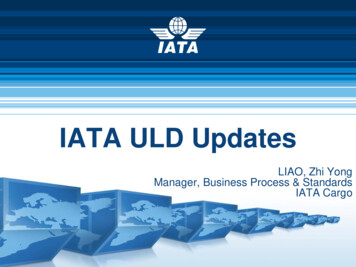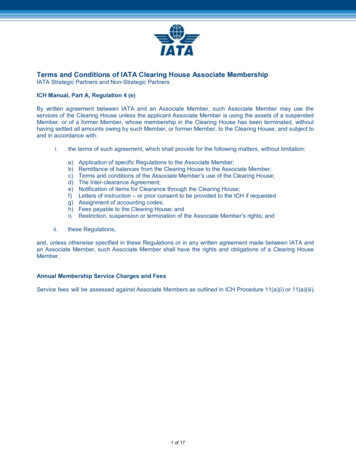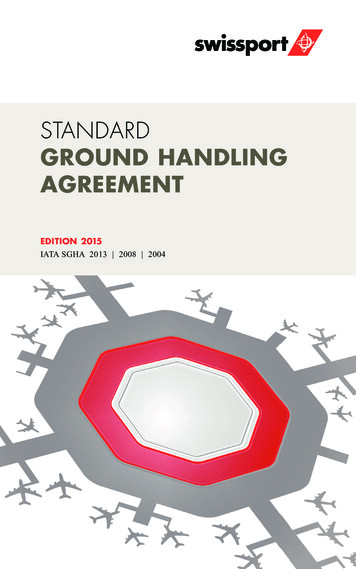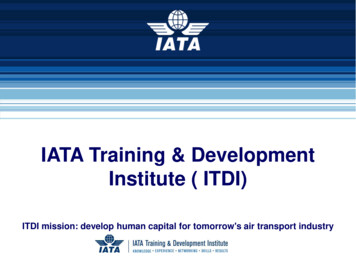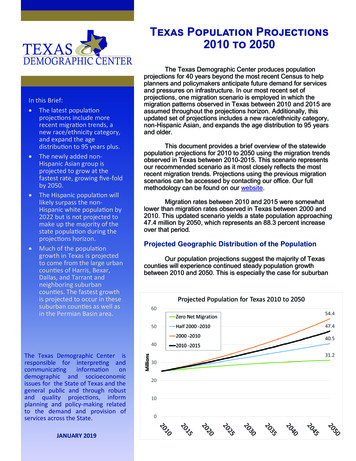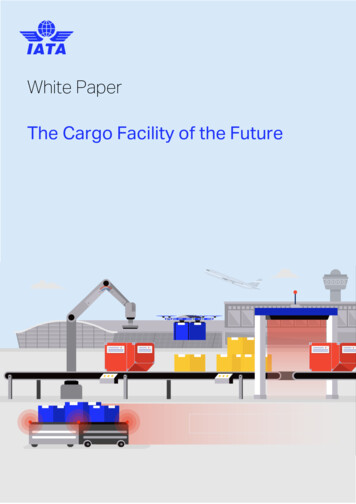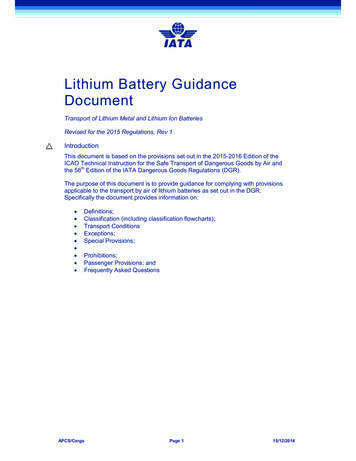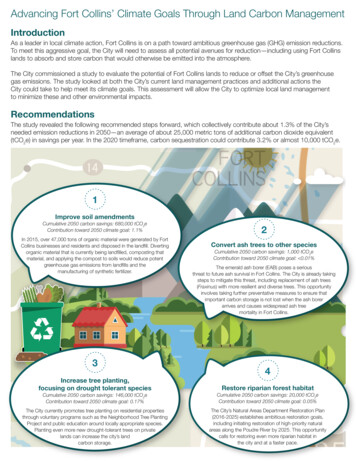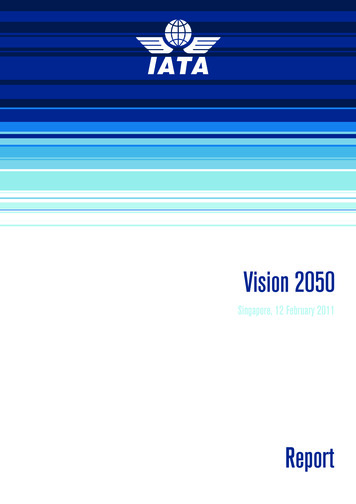
Transcription
Vision 2050Singapore, 12 February 2011Report
The passenger is at the core of our 2050 thinking. Over the last four decades the real cost oftravel has fallen by about 60% and the number of travelers increased tenfold. We must continueto provide this great value to individual consumers and to society. To do so we need the righttechnology, efficient and sufficient infrastructure. And we need financial sustainability. Nobodyhas all the answers or a crystal ball to see the industry in 2050. But there was consensusamong all present that there is strategic value in thinking together. And there was generalconsensus that one of the industry’s biggest challenges is to evolve from the financial disasterof a partial deregulation that has created fierce competition among airlines but without givingthem the normal commercial freedoms to do business. The industry is sick. To protect the valuethat aviation delivers to consumers, companies, countries and the global economy, we needa common vision to change as we move forward.Giovanni BisignaniSingapore, 12 February 2011
Vision 2050Singapore, 12 February 2011International Air Transport AssociationMontreal — GenevaReport
ninformationcontainedcontainedin inthisthispublicationpublicationis subjectis subjectto toconstantconstantreviewreviewin inthethelightlightof cribersubscriberor hebasisbasisof utreferringreferringto beenbeenmademadeto esponsibleforforanyanylosslossor ordamagedamagecausedcausedby intsor ormisinterpretationmisinterpretationof xpresslydisclaimsdisclaimsanyanyandandall allliabilityliabilityto toanyanypersonpersonor orentity,entity,whetherwhethera apurchaserpurchaserof ofthisthispublicationpublicationor ornot,not,in inrespectrespectof ofanythinganythingdonedoneor ncesof ofanythinganythingdonedoneor oromitted,omitted,by byanyanysuchsuchpersonpersonor orentityentityin reliancein relianceononthethecontentscontentsof ofthisthispublication.publication.Note: Unless specified otherwise, all dollar ( ) figuresin this report refer to US dollars (US )VisionVision20502050 20112011InternationalInternationalAir AirTransportTransportAssociation.Association.All rightsAll rightsreserved.reserved.MontrealMontreal— Geneva— Geneva
Table of ContentsForeword. iiiSection 1. Profitability. 11.1 Industry value creation. 41.1.1 The value provided by the airline industry. 41.1.1.1 The size of the industry. 41.1.1.2 Costs and prices. . 71.1.1.3 Quality.111.1.1.4 Summary. .141.1.2 Airline profitability.141.1.2.1 Airlines that have created shareholder value.141.1.2.2 Industry level profitability.171.1.2.3 Value creation in the wider airline industry value chain.181.2 Understanding airline profitability: what drives the industry’spoor financial returns?.211.2.1 Actors in the airline industry.221.2.1.1 Customers.221.2.1.2 Suppliers.231.2.1.3 Potential entrants.261.2.1.4 Substitutes.261.2.1.5 Airline rivals.261.2.2 Industry scope and segmentation.291.2.3 Five Forces in the airline industry.301.2.3.1 Intensity of rivalry. .311.2.3.2 The threat of new entrants. .371.2.3.3 Bargaining power of customers. .381.2.3.4 Bargaining power of suppliers.401.2.3.5 The threat of substitutes. .421.2.4 The role of government.431.2.5 Implications.451.3 Different angles of view.471.4 Improving airline profitability: towards a path to sustainable industry returns.501.4.1 Why does airline profitability matter?.501.4.2 Is industry structure already improving?.52IATA Vision 2050 i
1.4.3 How failures in airline industry structure can be overcome.531.4.3.1 Reduce artificial barriers to exit and consolidation.531.4.3.2 Reduce artificial incentives for entry and capacity expansion.541.4.3.3 Change the way airlines compete.551.4.3.4 Reduce unnecessary system costs through policy changesand better coordination.551.4.3.5 Recommendations to avoid.561.4.4 Conclusions: moving to action.56Section 2. Consumer.592.1 Discussion highlights.592.2 Thought piece: an optimistic view of the customer of the future.602.2.1 The world in 2050.602.2.2 The airline industry in 2050.612.2.3 Who are our customers in 2050?.612.2.4 What are our customers’ priorities in 2050?.62Section 3. Infrastructure.653.1 Discussion highlights.653.1.1 ANSPs.653.1.2 Airports.653.2 Vision 2050 thought piece: the future of infrastructure.663.2.1 2050: the dawn of a new age for air travel.663.2.2 The drivers for change.673.2.3 Air traffic enablement.683.2.4 Airports.69Section 4. Technology.734.1 Discussion highlights.734.2 Thought piece: powering the future.744.2.1 Introduction.744.2.2 Changes in aircraft configuration.754.2.3 Improved efficiency engines and engine architectures.754.2.4 The aircraft are different on the inside as well as on the outside.764.2.5 How quiet/clean can you go?.764.2.6 You still need energy dense, liquid hydrocarbon fuel.764.2.7 Increased aircraft operating capability from information sharing .774.2.8 Any other business .77ii IATA Vision 2050
ForewordA decade of change has transformed aviation. Airlines are leaner, greener, safer and stronger.The industry had also grown to meet the needs of a globalizing world. Compared to 2001, freight shipmentsexpanded by 17 million tonnes to 46 million annually. At the same time, air travel became accessible to abillion more travelers a year and we expect 2.8 billion people to fly in 2011.The decade also saw industry revenues double to an expected 598 billion. But industry profits are muchless impressive. Over the last 40 years, the average net margin is 0.1%. And even in the best year of the lastdecade – 2010 – the industry’s 18 billion profit is equal to a pathetic margin of just 3.2%, that does notcover the 7-8% cost of capital.Looking ahead, we can see that in 2050 aviation will fly 16 billion passengers and 400 million tonnes of cargo.We must be able to manage that with sustainable technologies and efficient infrastructure, while pleasing ourpassengers and rewarding our shareholders. At the 2010 IATA Annual General Meeting, I announced Vision2050 with these principles as cornerstones. And I invited 35 strategic thinkers to challenge and develop thisvision.The group benefited greatly by the inspirational and strategic leadership and wisdom of Singapore’s MinisterMentor, Lee Kuan Yew. And Harvard University Professor, Michael Porter, helped us to frame our analysis withhis insights on global competitiveness.Vision 2050 did not identify a silver bullet to secure a more successful future. The papers that follow highlightthe need for ongoing change.First, we must break down the silos that dominate the industry’s value chain. This will allow for a rebalancingof financial reward to reflect the risk taken. By working together as a united industry, we can create new valuepropositions for our customers and move away from destructive competition based solely on price.Second, we must challenge governments to join us in change. This means replacing interventionist micromanagement and punitive taxation as the modus operandi of many, with a positive approach based on a levelplaying field and focused on commercial freedoms.Third, we must embrace the reality of an industry whose centre of gravity is shifting away from our traditionalleaders in the US and Europe. Asia-Pacific is already our biggest market. The continued development ofChina and India will keep this region at the industry’s forefront. We must engage the region to deliver leadership for change.The last decade has shown that by working together with a common purpose, change is possible. Vision2050 is not a roadmap to the future. Flexibility and openness to change will mark the way forward. Instead,Vision 2050 is a challenge to all aviation stakeholders – to unite in articulating and delivering a dynamic visionof our wonderful industry’s future.Giovanni BisignaniDirector General & CEO – IATAiii IATA Vision 2050
ParticipantsIATA’s Vision 2050 Summit in Singapore, 12 February 2011, brought together a group of strategic thinkers, representing a broad range of industry stakeholders. Participants included government ministers, regulators, airlines,manufacturers, technologists, financiers, airports, air navigation service providers, labor and consumers.Lee Kuan Yew – Minister Mentor, SingaporeAnthony Albanese – Minister for Infrastructure and Transport, AustraliaRaymond Benjamin– Secretary General, International Civil Aviation OrganizationYashwant Bhave – Chairman, Airports Economic Regulatory Authority, IndiaPhilip L. N. Chen – Former CEO, Cathay PacificChew Choon Seng – Former CEO, Singapore AirlinesJosh Connor – Head of Transportation & Infrastructure Investment Banking, Morgan StanleyNader Dahabi – Former Prime Minister of JordanKevin Done – Former Aviation and Aerospace Journalist, Financial TimesRod Eddington – Former CEO, British AirwaysTony Fernandes – Group CEO, AirAsiaEdward M. Greitzer – H.N. Slater Professor of Aeronautics and Astronautics, MITJohn Grier – Group Head of Global Transportation Investment Banking, CitibankPaul Griffiths – CEO, Dubai AirportsCarlos Limon – President, International Federation of Air Line Pilots’ AssociationsLim Hwee Hua – Second Minister for Finance and Second Minister for Transport, SingaporeThierry Lombard – Managing Partner, Lombard Odier Darier Hentsch & CieWolfgang Mayrhuber – Former CEO, Deutsche LufthansaDavid McMillan – Director General, EurocontrolRobert Milton – Chairman & CEO, ACE Aviation Holdings Inc.Max Moore-Wilton – Chairman, MAp Airports GroupLeo F. Mullin – Former CEO, Delta Air LinesRonald K. Noble – Secretary General, INTERPOLBen Page – Chief Executive, Ipsos MORIJosé Huepe Pérez – Former Director General of Civil Aviation, ChileEmilio Romano – President & CEO, Air Group Latin America (AGL)Sir John Rose – CEO, Rolls RoyceAshley Smout – CEO, Airways New ZealandDoug Steenland – Former CEO, Northwest AirlinesChris Tarry – Aviation Industry Research and Advisory, CTAIRASteven Udvar-Hazy – Chairman & CEO, Air Lease CorpGirma Wake – Former CEO, Ethiopian AirlinesMichael E. Porter – Harvard Business SchoolBrian Pearce – Chief Economist, IATAKevin Dobby – International Aviation Adviseriv IATA Vision 2050
Lack of profitabilityis driven by poor industrystructure, misguidedgovernment intervention andinconsistent strategy choices
1Section 1. ProfitabilityVision 2050 – Structuring for ProfitabilityProduced with the assistance ofProf. Michael E. Porter, Bishop William Lawrence University Professor, Harvard Business SchoolBrian Pearce, IATA Chief Economist and Visiting Professor, Cranfield UniversityAir transport markets and the airline industry have been transformed over the last 40 years. The numberof passengers has risen tenfold and cargo volumes have grown fourteenfold, despite repeated shocksfrom recessions, terrorism and disease. Demand is volatile but consistently returns to a rapidly growingtrend. Supply has also changed significantly. Having been a highly regulated industry during the firstthree post-war decades, market access was increasingly liberalized starting with US domestic marketsin the late 1970s, followed by US ‘Open Skies’ policy on international markets from the early 1990s,and the European single aviation market in the mid-1990s. There have been many new entrant airlines inthe past three decades, while exit has been limited. As a result, the number of commercial airlines, flyingWestern-built jets, has risen to over 1,000.Consumers and the wider economy have reaped the benefits of a substantial increase in the choice oftravel options by destinations, frequencies, and business models available at lower cost, higher safety,and a smaller environmental footprint per passenger mile traveled than ever before. Airline owners have,however, not even been able to recover their cost of capital. This paper aims to identify the root causesfor this imbalance, and to suggest steps to address it. The goal is an industry that continues to growthe value provided to consumers while earning returns that sustain further productivity improvements.Chapter 1 provides detail on how the substantial value being created by the airline industry has largelybeen captured by consumers and some suppliers. Chapter 2 then analyzes the economic forces thathave driven these outcomes, applying the Five Forces framework as an analytical tool. Chapter 3 buildson this analysis to understand whether the current path is sustainable and, if not, how it can be adjusted.1 IATA Vision 2050
1Executive SummaryIn the past 40 years the volume of air travel has expanded tenfold and air freight has grown by a factorof fourteen. The world’s economies have grown three to four times over the same period. Air transporthas been one of the world’s fastest growing economic sectors.Travel markets do mature, and many of the OECD markets have seen growth slow. But there is still hugeuntapped potential to provide air transport services connecting the growing megacities and populationsof the BRICs. The centre of gravity of the industry is shifting eastward. In these regions demand for airtransport is set to expand substantially over the coming decades.In meeting this demand the industry has benefitted from airframe and engine technology improvementsthat have doubled fuel efficiency in the past 40 years. Airline have also substantially raised asset utilization and delivered large productivity improvements for all their major inputs. The unit cost of air transporthas more than halved over this period as a result.Utilization and productivity gains were driven by changing business models and substantially increasedcompetition, as liberalized market access became widespread over this period and many new airlinesentered the industry. This has been a tremendous benefit to the consumer. Virtually all of the reductionin unit costs over this period has been passed on through a halving of the real cost to consumers of airtravel and air cargo.By contrast the shareholders of airlines over this period have seen no return to compensate them fortheir risk taking. Over the past 40 years the net post-tax profit of the airline industry worldwide has averaged a paltry 0.1% of revenues. There are a small number of airlines that do consistently generate areturn on capital that exceeds its cost. They include airlines small and large, LCCs, full-service networkand regional airlines, and can be found in all the major regions. There is no simple, obvious reason fortheir success compared with the persistent poor profits of the majority of the industry.Suppliers and other industries in the air transport value chain do generate sufficient profits to pay investors a normal return, in some cases with returns on capital well into double figures. Airlines stand out inthe value chain as earning the lowest returns and bearing virtually the highest risk. However, the mostprofitable sectors in the value chain are relatively small compared to the capital invested in the airlines.There is today over 500 billion of investors’ capital tied up in the airline industry. In a ‘normal’ industryinvestors would earn at least the cost of capital, implying a return of 40 billion a year. In fact, over thepast decade investors have seen their capital earn 20 billion a year less than it would have investedelsewhere. Even at the top of the last cycle over 9 billion of investor value was destroyed.Michael Porter applied his Five Forces framework to illuminate the reasons why airline profitability is sopoor; through the forces of rivalry, new entrants, customer and supplier bargaining power, and the threatof substitutes. There are few industries where all five forces act so strongly to depress profitability asthey do in the airline industry.Rivalry is intense, driven by a perishable product, difficulty in sustaining product differentiation, highfixed and low marginal costs, high exit barriers, capacity that can only be increased stepwise, and volatile markets.The threat of new entrants is also high. Over 1,300 new airlines were established in the past 40 years.Barriers to entry are low as market access is increasingly liberalized, economies of scale in operationsare limited, access to distribution channels is easy and consumer switching costs are low.2 IATA Vision 2050
1Moreover, the bargaining power of customers is high and rising. Channels have become significantlymore concentrated, travel agents more aggressive in pursuing the interests of end corporate customers,a significant share of end customers is highly price sensitive and for whom the impact of loyalty programsis limited.The bargaining power for suppliers of several critical airline inputs is high. As a group suppliers earnhigher returns than their cost of capital, and returns are significantly higher than for airlines. Manufacturing is a highly concentrated oligopoly, labor unions have been powerful in a number of airlines, manyairports and ground handling companies are local monopolies.The most powerful substitute to air travel is the decision not to travel, particularly for leisure travel.The threat of other substitutes has also started to become more significant in some segments, with highspeed trains, private jets and the improvement in video conferencing technology.The Five Forces analysis reveals the deep underlying challenges facing airline profitability. Some otherindustry share similar product, industry and market features but nonetheless generate returns for theirshareholders. The reason why the airline industry differs lies in government policies, strategic choices byairlines and the behaviour of suppliers.The nature of government intervention is a key reason for poor airline profitability. Restrictions on crossborder investments, the nature of bankruptcy procedures, and subsidies for failing airlines are some ofthe key barriers that keep the industry from adopting a more effective structure.A number of airline strategy choices appear individually rational but in aggregate contribute to a marketenvironment that is worse for everyone. Competition is too often on size and network breadth, ratherthan on differentiation. Supplier behaviour creates further challenges.Does poor airline profitability matter? Regulators will only care if there are societal costs. When airlinesare forced into bankruptcy, there clearly are major costs. Fragmentation is also costly. The benefits ofgreater consolidation in terms of reduced congestion, emissions and efficiency have been substantial.There are a number of lessons. Artificial barriers to exit and consolidation need to be removed. Artificialincentives for entry and capacity expansion also need to be addressed. Airlines need to change (but notreduce) the way they compete. Unnecessary system costs must be reduced through policy change andbetter coordination.Moving to action requires the airline industry to invest in coherently documenting the benefits it providesin the global economy. For change to happen industry efforts must be framed as a campaign to reducethe societal costs of poor industry structure. All recommendations need to be supported by documenting the benefits for each stakeholder asked to act. The action agenda should build on the positivetrends already under way, and needs to be communicated by the airline industry through one voice. Tobuild momentum, initial focus should be on steps that can be taken by IATA, individual companies ormore enlightened countries.3 IATA Vision 2050
11.1 Industry value creationThis chapter describes how airlines add value to the inputs used in supplying air transport services,and how virtually all of that value is captured by consumers and the wider economy. We first look at therapid expansion of air transport volumes and how income growth in the BRIC economies, together withincreasing connectivity between major cities, will keep this a high-growth industry in coming decades.Next we examine the structure of costs and how substantial efficiency gains have been passed fullythrough to consumers in lower real transport prices. We also look at various facets of service quality.Finally we examine profitability. The few airlines that have created shareholder value are identified.We then report on a detailed assessment of the return on invested capital along the airline supply chainand, in particular, the persistent economic losses by the airline industry as a whole.1.1.1 The value provided by the airline industry1.1.1.1 The size of the industryIn the past 40 years the volume of air travel, as measured by worldwide scheduled RPKs (revenuepassenger kilometers), has expanded tenfold. This is an expansion three times greater than the growthof the world’s economies, which partly reflects the high income elasticity of air travel. It also reflects, andhas facilitated, globalization. Air travel has risen broadly in line with world trade during the past 40 years.It has been one of the fastest growing economic sectors.Chart 1: Air travel has expanded tenfold in the past 40 yearsSource: ICAO, IATA, Haver4 IATA Vision 2050
1Air travel initially grew faster than world trade. As OECD markets matured in the 1990s and 2000s,average income elasticity declined and air travel grew more slowly than world trade.Chart 2: Travel markets at very different stages of developmentSource: IATA PaxIS, IMFTravel markets do mature. The evidence suggests that once real GDP per capita reached 15,000 20,000 the number of trips by air per head of population levels out. Today’s large markets in the USand Europe are approaching saturation. However, the BRIC economics have very underdeveloped travelmarkets and are likely to be a very large source of new travel demand in the decades ahead.Chart 3: Air freight has a higher share of world trade todaySource: ICAO, IATA, HaverAir freight (freight tonne kilometers, FTKs) also saw initial growth at a faster pace than overall trade ingoods, reflecting the globalization of business supply chains and increasing international trade. Fast,though costly, air freight is a key enabler of just-in-time inventory management. In the past decade airfreight has moved in line or more slowly than overall world trade. Air transport is both driven by andenables globalization.5 IATA Vision 2050
1Urbanization is also key to the development of the industry. The air transport network is all aboutlinking cities and urban agglomerations. The 26 ‘megacities’ of the world, with populations in excess of10 million, account for more than 20% of air travel worldwide. There are 62 urban agglomerations withpopulations of 5 million or more, which generate 40% of air travel worldwide. As chart 4 showsmost growth in capacity over the past 40 years has taken place on city-pairs with a major hub city(the 26 megacities plus the next 6 largest urban agglomerations) at one or both ends. Growth inservices between smaller cities has been much slower. This industry-wide picture conceals the currentconcentration of air services between megacities in the OECD economies. The 15 megacities in Asiaand the 6 in Latin America are relatively underserved and promise further substantial network development in the coming decades.Chart 4: Majority of network growth has been between large hub citiesSource: Airbus, OAGConsumers have benefited over the past 30 years from a 2.5 times rise in the number of weeklyfrequencies, a service quality feature particularly valued by time-sensitive business travelers, and alsoa doubling of non-stop city-pair origin-destinations.Chart 5: Network development has connected more city-pairsand added frequenciesSource: Boeing, OAG6 IATA Vision 2050
11.1.1.2 Costs and pricesOver the past 40 years the real cost of
1.2 Understanding airline profitability: what drives the industry's . Michael Porter, helped us to frame our analysis with his insights on global competitiveness. Vision 2050 did not identify a silver bullet to secure a more successful future. The papers that follow highlight the need for ongoing change.
